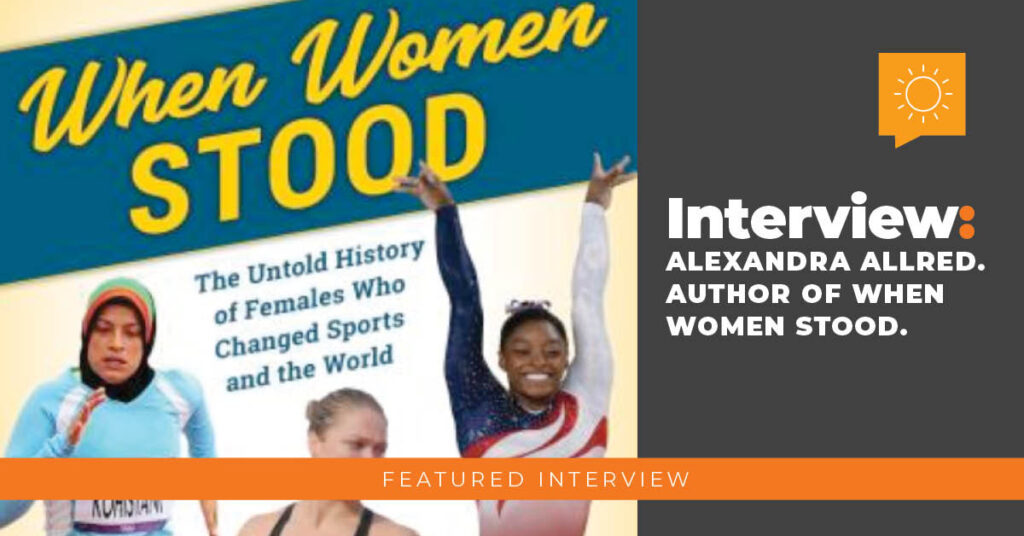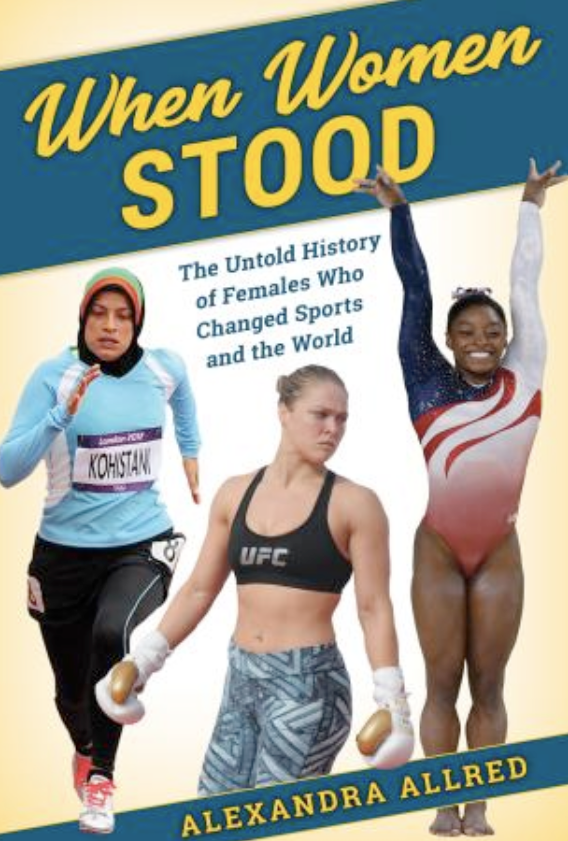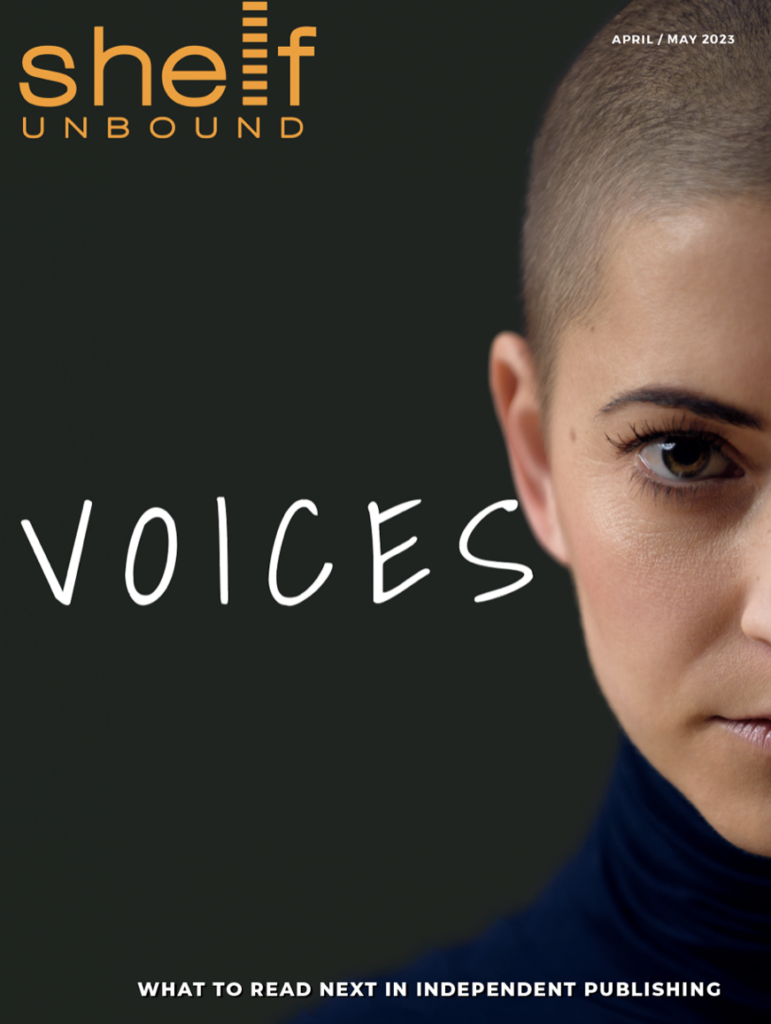

Tell us a little bit about When Women Stood
AA: It is the bible of women’s sports history. It is both a tribute to women in history but also an eye-opener as to how the female image has been historically written and re-written. It is a story of neglect and abuse, to be sure, but it is also an empowering read about incredible, funny, brave, strong and determined women. There are many, many names you will recognize but so many more you never heard of. You will be shocked by the real history of how women’s clothing sizes are determined, who was first to #takeaknee, and who pushes the concept of beauty, but you’ll also walk away realizing just how cool the female athlete truly is. The story of the Night Witches encapsulates just how strong women are. They did in three months but took the men three years. As former politician Ann Richards once said, “If you give us a chance, we can perform. After all, Ginger Rogers did everything Fred Astaire did, she just did it backwards and in high heels.”
What inspired you to write the book?
AA: After teaching kinesiology for more than two decades, I grew frustrated that textbooks created for tomorrow’s medical professionals, physical and occupational therapists, personal and athletic trainers, coaches, sports media and marketing professionals, as well as athletes gave just one or two pages to the female athlete in a 300-page resource. The female athlete continues to be neglected in modern medicine and exercise science research. While women react differently to a great number of medications, the 154-pound male is, unbelievably, still used as a model to represent females. Too much remains unknown about hormones, cycles, pregnancy and abuse in sport. It was time to create a book that offered research but also much needed dialogue regarding all things female in sport. A women’s sports book is wildly different from that of the male’s sporting history and experience.
How did the idea originate?
AA: I had begun to incorporate historical overviews of women in early sport well over a decade ago to give my students – all my students – greater perspective and knowledge. How could I not? I knew the probability of a male coach working with female athletes was high so there were things they needed to know. I offered information on the Female Triad, ‘bikini medicine’ and menstrual cycle but when COVID appeared in early 2020 and teaching went remote, I began more intensive research. I had kicked around the idea of a ‘The Female Athlete’ 30-page manual that I planned to print up and hand out on my own dime for students. But when I learned more about the 154-pound male model and how our top medical universities are still excluding biological females from science and medicine, I knew it was time to create a women’s sports history book that was both commercial and academic. My dream is to have kinesiology programs around the nation adopt this book into their curriculum but I would also love to have younger female athletes and coaches read about the female athlete’s history. Despite what images we are shown, our early female pioneers are some of the strongest, bravest people who have been ignored in history.
What is your background in regards for female athletes?
AA: Beyond the horrible history of women and medicine, the continued discriminatory practices of national governing sport agencies around the world were still a problem. In 1993, I was sitting on my couch watching ESPN, holding my six-month-old baby when the sport of bobsledding came on screen. I was enthralled. What an exhilarating sport! I could not wait to see the women but they never came. I did not yet have email. I didn’t even know what email was at the time but I did have a library and with a little research, I was shocked to learn that women had been banned from the sport.
Only after Katharine Dewey (great granddaughter of Melvil Dewey of the Dewey Decimal System) won the 1940 AAU’s U.S. National Four-Man Bobsled Championships and became the only woman to win a national championship in any sport in open competition against men. Days later, the AAU stripped Dewey of her medal, banned women from the sport and declared it too dangerous for the ‘fairer’ sex.
Oh… hell … no. And so began my letter writing campaign to the USOC, IOC, National Bobsled and Skeleton Federation, Sports Illustrated, ABC Wide World of Sports, etc. Without ever having step foot into a bobsled, I challenged people to a race. What was I thinking? I just knew this was not right. Soon enough, I received a phone call. The IOC mandated that women were to be included in the bobsleigh programs. The U.S. Bobsled Federation was not at all happy about this demand. This became evident when we were denied a coach, proper equipment and even instruction on how not to get killed going down the mountain. When we got a sponsor for equipment, the men attempted to steal it and when we traveled overseas, it was a disgusted Canadian coach who helped us after watching a horrific crash. The famous Jamaican bobsled team befriended us and we even received help from Prince Albert of Monaco’s bodyguards at a World Cup in Switzerland when it was apparent we were on our own. While the goal was to make the women go home, it would be us who broke the U.S. losing streak and brought the county its first gold Olympic medal in over 50 years.
My interest in how the medical community has and has not served women (over half the world’s population) initially stemmed from my experience as a pregnant bobsledder. The only information female athletes could get in the 1990s was “don’t let your heart rate go over 140 bpm,” and so I also became part of an international study for elite pregnant athletes. It was then that I first learned what too few females know – we are terribly neglected by medical institutions.
Did the book involve special research?
AA: Yes. I realized early on that the experience of fair play is not just different between the male and female athlete but also among females within sports. The Latina athlete, for example, did not make her first strong showing in sport until the 1990s. This always surprises people but with an exceptionally hyper-sexualized image and very strong patriarchal family values, the Latina female athlete endured a lot – too much. The Black female athletes’ early experiences were so drastically different from the White female experience that I gave special attention to the backstory of non-white women entering sport, including Indigenous female athletes. As an educator, author, and researcher, I believe it would have been negligent to ignore these facts. As explained in the book, our early pioneers in women’s sports could have only been wealthy, educated, white women. Even then, many were threatened with legal action and death threats for riding a bicycle and flying a plane.
What were some of your favorite facts or stories you learned about female athletes in writing/researching this book?
AA: Admittedly, the 154-pound male model for females was upsetting. Learning that (on average) three women a day in the United States are killed by an intimate partner and/or that of all the wealthy (Western) nations in the world, U.S. women are most likely to die during child birth was a jolt. That is, until I read that even as recent as 2018 the Association of American Medical Colleges and the American Medical Association actively refused to recognize the value in requiring education and research on female patients. Instead, they put the onus on already overworked and exhausted medical student to learn on their own time. The message is clear: women don’t matter. This is a recurring theme through not only the female athlete’s experience but for women as a whole. Why? Because the female’s hormones make her too expensive to research.
But what continues to surprise and disappoint me most is at the end of each semester, I ask my students “what can be done,” in regards to the issues of hyper sexualizing female athletes, abuse of and/or rape on campus. What can be done about the neglect of women in medicine or the rush to allow transgender female athletes in women’s sports when we do not yet know enough about cisgender female athletes. Throughout the course, we discuss topics from the book that include the purpose of Title IX, the hegemonic feminine ideal, negative media images, on and on. Yet I still get responses such as “This is just the way it is for women. It is sad but nothing can be done.”
Even our young adults are hard-wired to believe that females simply must endure abuse, early death, neglect, and discrimination.
Repeated images of slain, kidnapped, beaten, and abducted females (all ages) now appear normal. When a men’s magazine listed “hottest female athletes” to include 15- and 16-year-old athletes, this was considered normal. And when yet another magazine actually printed an article about female athletes who had stalkers, the author explained that it was to be expected if the athlete was “hot.”
How is this book different from others?
AA: As difficult as many of the topics were (and are), I knew I must not shy away from such topics as abortion, bikini medicine, rape, discrimination, differences between the white and non-white female experiences, sexualized female images, breast implants, ‘mean girls,’ equal rights, and the entry of transgender female athletes in women’s sports. These are our realities. The history, science, and social acceptance – or not – of all of these issues are part of the female athlete’s experiences and must be talked about in earnest.
Women’s sports tend to highlight a single athlete, team, or sport rather than invite everyone in to talk about hormones, sponsorship or scholarships, violence, inadequate coaching, and neglect from both the medical and media communities. As Bev Francis, who once entered a bodybuilding competition as one of the strongest women in the world, once said, “I should have come in first or last.” While male athletes can be extremely unattractive, no one cares if he’s the best. Francis, however, was not considered attractive. The judges had no idea what to do with the most symmetrically muscular woman on the circuit and so they gave her 8th place – the middle of all competitors. Flash forward to 2022 in which just 6% of all sports science research is dedicated to the female athlete because top universities are not sure what to do with someone who has menstrual cycles, fluctuating hormones, body fat and weight. She is symbolically set in the middle where institutions recognize 44% of all collegiate athletes are females but do not want to invest time, money, data into learning more about her.

Alexandra Allred was born in Frankfurt, Germany into a military family and spent much of her life traveling to many not-so-romantic locations. Many of her stories of Allred and her sister almost dying on Air Tunisia, sleeping on giant moths in Africa or being chased by the KGB in Moscow as youth are well-documented, as are her exploits as the first-ever US female bobsled champion.
Her first award-winning book, ‘Atta Girl: A Celebration of Women in Sports,’ began her sports writing career. But in 2002, after her son’s illness, Allred turned to environmentalism and lobbying on Capitol Hill and, eventually, fiction. IPPY Award winning book ‘Damaged Goods’ was her break-out fiction — a suspense/drama/comedy based on real life. Today, Allred scripted the award-winning TV pilot, ‘Spy Lies,’ based on her family, and is focused on helping the special needs community.
Allred created a fitness program specifically for those living with special needs and recently released Operation Caregivers: #LifewithDementia. Today, she lives with her family outside Dallas, Texas.

